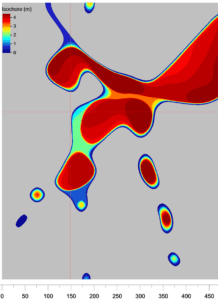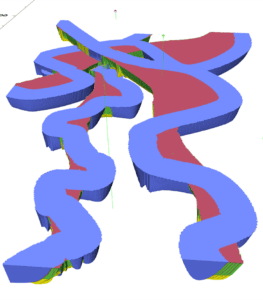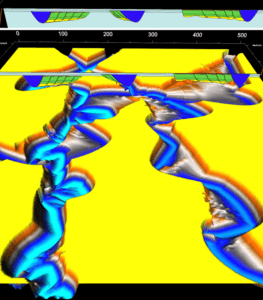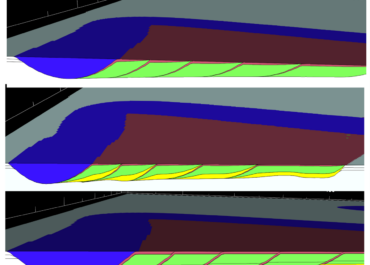Unveiling the Subsurface Mysteries:
ReservoirStudio’s Geologic Rule-Based Modeling in Fluvial Environments
SubsurfaceAI proudly announces the integration of ReservoirStudio into our latest 2024.1 release, marking a significant advancement in reservoir modeling capabilities. ReservoirStudio is distinguished from its predecessors by its utilization of a geologic rule-based methodology to render intricate three-dimensional architectures within reservoirs, providing a more nuanced understanding of subsurface environments, particularly in fluvial settings.
The Complex Underworld of Point Bar Sand Reservoirs
Point bar sands are a crucial reservoir type within the fluvial depositional environment, known for their significant role in hydrocarbon accumulation. These deposits, however, pose a challenge due to their intricate internal structures that significantly affect fluid flow patterns. The traditional approach to modeling these features has been to create isochore maps based on well data, outlining the spatial distribution of point bar sands. Yet, this method falls short in capturing the true complexity within the point bars, often leading to oversimplified reservoir models that can hinder effective development and management plans.
ReservoirStudio’s Innovative Approach
ReservoirStudio transforms this conventional mapping with its advanced geologic rule-based system. By integrating well data with geological principles, ReservoirStudio crafts a detailed three-dimensional representation of the subsurface, revealing the heterogeneous nature of point bar deposits far beyond what seismic resolution can discern.
Figure 1: The Isochore Map
An isochore map of point bar sand in a fluvial reservoir provides the first layer of understanding, offering a bird’s-eye view of sand distribution. Although valuable, this perspective lacks depth in terms of the internal complexities of the point bar architecture.
Figure 2: The 3-D Architectural Model
The three-dimensional model generated by ReservoirStudio illustrates the sophisticated layering within the point bar. It showcases the cross-sections of the point bar, which are critical to understanding the depositional environment and the resultant heterogeneity.
Figure 3: Cross-Sectional Layering Patterns
This figure dives deeper, displaying three distinct types of layering patterns within the point bar. These layers are the fingerprints of the historical flow regimes and sedimentary processes, holding the secrets to the permeability and porosity that control fluid flow.
Figure 4: Paleo Surface Reconstruction
The paleo surface reconstruction offers a snapshot of the geological past, providing insights into the depositional environment at the time of formation. It’s a crucial piece of the puzzle in predicting the behavior of fluids within the reservoir.




Implications for Reservoir Development
The detailed models generated by ReservoirStudio are not just academic exercises. They are vital tools for devising effective reservoir development strategies, infill-drilling programs, and CO2 storage modeling. Understanding the subsurface at this granular level allows for more precise prediction of fluid behavior, resulting in improved recovery rates and more efficient reservoir management.
Driving Towards a Sustainable Future
As the energy industry moves towards a more sustainable future, the ability to accurately model CO2 storage in geological formations becomes increasingly important. ReservoirStudio’s capabilities extend beyond hydrocarbon production, providing the tools necessary to tackle the challenges of geologic CO2 storage and help mitigate the impact of climate change.
Conclusion
ReservoirStudio, now an integral part of SubsurfaceAI, stands at the forefront of reservoir modeling technology. Its geologic rule-based methodology deciphers the complexities of fluvial environments, offering a revolutionary approach to understanding and managing the subsurface. As we continue to push the boundaries of technology and innovation, SubsurfaceAI remains committed to unveiling the mysteries hidden beneath our feet and guiding the energy industry towards a more informed and sustainable future.
Contact us if you have any questions about this article or any of our other products.
